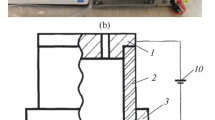Abstract
The growth of porous anodic Al2O3 films, formed potentiostatically in continuously stirred 15 wt.% H2SO4 electrolyte was studied as a function of the anodization voltage (14–18 V), bath temperature (15–25 °C) and anodization time (15–35 min). The variation of the anodic surface overpotential with the current density was measured experimentally. The film thickness at the more accessible portions of the anode was observed to increase with the anodization voltage and the bath temperature. However, the film thickness on the less accessible portions of the anode did not significantly change with the voltage or the bath temperature. This indicates that the anodization process at the more accessible regions is more strongly influenced by the surface processes than by the electric migration within the electrolyte. Furthermore, analysis confirms that the major portion of the film resistivity resides within a thin sub-layer that does not vary with the anodization time, and the growing anodic layer contributes only marginally to the overall film resistance. Computer aided design software was employed to simulate the current density distribution. For the range of process parameters studied, the electrochemical CAD software predicts accurately the measured thickness distribution along the anode.
Similar content being viewed by others
References
F. Keller, M.S. Hunter and D.L. Robinson, J. Electrochem. Soc. 100 (1953) 411.
G. Patermarakis and K. Moussoutzanis, Electrochim. Acta 40(6) (1995) 699.
G. Patermarakis, P. Lenas, Ch. Karavassilis and G. Papayiannis, Electrochim. Acta 36(3/4) (1991) 709.
G. Patermarakis and K. Moussoutzanis, J. Electrochem. Soc. 142(3) (1995) 737.
G. Patermarakis and D. Tzouvelekis, Electrochim. Acta 39(16) (1994) 2419.
S. Ono and N.Masuko, Surf. Coatings Technol. 169-170 (2003) 139.
J.M. Albella, I. Montero, O. Sanchez and J.M. Martinez-Duart, J. Electrochem. Soc. 133 (1986) 876.
M.C. Jimenez, J.M. Albella, I. Montero and J.M. Martinez-Duart, Electrochim. Acta 34(7) (1989) 951.
General Motors Engineering Standards GM9535P, March 1989.
L. Young, Anodic Oxide Films (Academic Press, London, 1961).
U. Landau, R.E. White and J. Newman (eds.), in Proceedings of the D.N. Bennion Mem. Symp., (The Electrochemical Society Proceedings 94-9, 1994).
J.S. Newman, Electrochemical Systems (Prentice-Hall, NJ, 1973).
''CELL DESIGN'', Computer Aided Design Software for Electrochemical Cells, L-Chem Inc., Shaker Heights, OH 44120.
Author information
Authors and Affiliations
Rights and permissions
About this article
Cite this article
Akolkar, R., Landau, U., Kuo, H. et al. Modeling of the Current Distribution in Aluminum Anodization. Journal of Applied Electrochemistry 34, 807–813 (2004). https://doi.org/10.1023/B:JACH.0000035611.87036.36
Issue Date:
DOI: https://doi.org/10.1023/B:JACH.0000035611.87036.36




